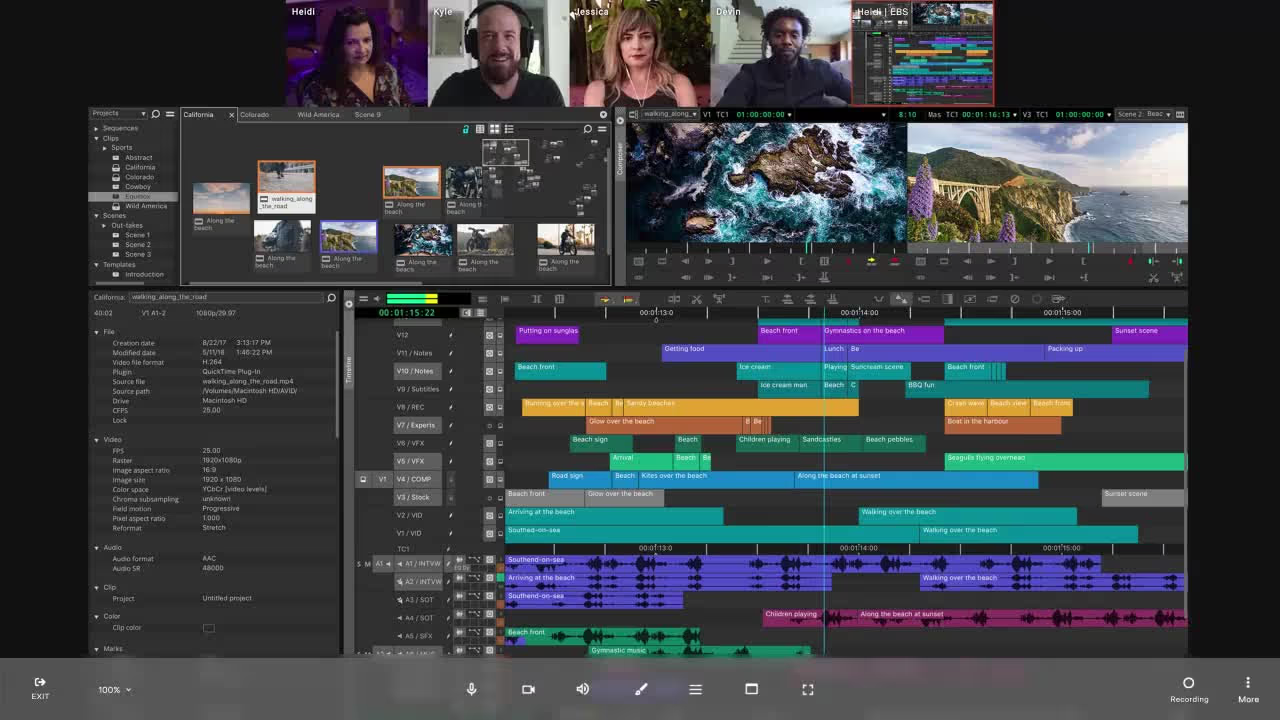Airplanes. Hotel rooms. Conference rooms. Vacation rentals. Cluttered offices. Heck, maybe even your dining room table.
What do all of these locations have in common? They’re inopportune places where you likely had to edit at some point in your professional journey just to get a project across the finish line.
If you’re lucky, you have a dedicated space designed for this purpose, containing all the tools necessary for your work. If you don’t, rest assured you’re not doomed to a life of calling every flat surface your computer lies on your workspace.
With a little know-how and the right hardware, software, and space, you can create a DIY home video editing studio that lets you produce the same professional, high-quality videos the industry expects.
In this guide, we walk you through the basic and next-level assets you need so you can set up the ideal film editing studio in your own home—and share some real-life examples to inspire your space.
What you need to build out your film editing studio at home
Hardware
You know you need hardware. But what kind of hardware can help take your workspace to a true home studio level? Since you already know and use the basics, we discuss some additional considerations for them below, then suggest a few that can help you take your setup to the next level.
For sourcing hardware, we recommend suppliers like B&H and Adorama. Along with comprehensive catalogs, they have knowledgeable pros who can answer questions in person and online. Local photo and video specialists are also great for this reason. However, if you know what you’re looking for, Newegg offers competitive pricing, while Best Buy is easily one of the most accessible.
Computer
Look, we know having a computer is obvious, but should you build off what you have or add to your arsenal? We know many creative professionals who have a laptop for portability and a dedicated desktop for their home studio setup. Others simply build on what they have. It’s really a matter of budget and preference.
If we had to choose, building a desktop for your home studio is the way to go. Parts and upgrades are generally cheaper, and most desktops are modular, allowing you to upgrade your RAM, graphics card, and internal storage as your projects and needs grow.
Displays, monitors, and/or projectors
Your current editing system already has a monitor, but you may need more. Additional monitors can significantly improve efficiency by giving you more space to work. Plus, they provide extra visual reference so you can see how your work looks on larger and smaller screens.
External storage
With a dedicated workspace, you no longer need to consider—or pay for—the convenience of more portable hard drives. We highly recommend switching to a redundant array of independent disks (RAID), allowing you to maximize storage capacity and transfer speeds. You also gain the safety of data redundancy, all for a fraction of the price of traditional external hard drives.
Studio headphones and monitors
Many editors use headphones or small speakers out of sheer necessity. While they’re still a crucial tool for audio reference, adding a set of professional-level headphones and studio monitors can undoubtedly improve your current setup.
That said, make sure you follow best practices to get the most out of your monitors. Have them isolated from the surface they sit on (most have foam bottoms to reduce vibration that may impact fidelity/accuracy) and correctly position them to achieve the best and most accurate sound (equidistant from each other and you, and aimed directly at you).
Next-level additions
Once you have the essentials, if you’re looking to step up your game (and workflow), you may want to include these options, too.
Editing controllers
For efficiency and accuracy, editing controllers can give your workflow a real boost. Consider color-coded and software-specific keyboards, control panels like Loupedeck and DaVinci Resolve, audio mixing boards, and tablets like Wacom for precise drawing, masking, and rotoscoping.
Green screen and camera
If you need to go beyond editing, having a green screen and video camera that meets your project’s quality standards can be a lifesaver for visual effects and compositing.
Reliable power
Save yourself the headache of losing work by getting an uninterruptible power supply (UPS) in case of unexpected power outages.
Software
Like our hardware recommendations, some of these software tools may be obvious but are still worth mentioning for a comprehensive home video editing bay.
Operating system
Consider our inclusion of this tool as just a reminder to make sure your OS and video editing software are compatible, especially if your home video editing studio includes an upgrade.
Editing software
DaVinci Resolve, Final Cut Pro, Adobe Premiere Pro, etc. Need we say more?
Collaboration and streaming software
Unless you’re working on a personal project, chances are you collaborate with remote team members or need to showcase your work to clients. Unfortunately, simple conference tools like Zoom often don’t cut it. They simply can’t handle the rigors of streaming high-quality video in real time.
Fortunately, there’s a handy solution for this: Evercast. Designed for professional-level video creatives (as well as music production and game development), Evercast allows users to collaborate in real time (up to 4K at 60fps) from any source with minimal lag (150ms average globally). The platform also offers comprehensive collaboration features and industry-leading support and security.

Evercast is an excellent way to maintain professional-level dynamics both in and out of your project (and office). Just ask Fred Paragano, CAS, who’s been nominated for three MPSE and two Primetime Emmy awards, won a Golden Reel, and is featured on multiple Grammy-winning albums:
“We used it for the spotting session [with directors and editors in San Francisco and producers in New York], and it worked flawlessly. The clients were very impressed—and that, of course, makes us look good, too…Being able to remain in my location but still work with clients worldwide opens up so many more possibilities.”
Create together remotely, in real time

Environment
Finally, your environment is a crucial factor in a truly comfortable and functional workspace, and, fortunately, these assets are easily attainable for most.
The right location
Depending on where you live, your options may be limited. However, if you have a few rooms to choose from, stick to those without too many windows (to reduce potential glare and outside noise), foot traffic (to minimize the risk of damage or interruption), and clutter (to give you enough space to house everything comfortably). And don’t forget proper cable management to keep your space as clean and functional as possible!
Lighting
Simply put, avoid harsh lighting. LED lights (especially controllable ones) and/or softboxes are best for creating non-intrusive ambient lighting for the best perception of color and detail. They can also reduce eye strain when you’re staring at bright screens for hours on end.
Acoustics
While not critical, good acoustics are important for reviewing audio, especially on monitors. If possible, get or build a few acoustic panels to reduce transient noise in the room. For a cheap fix, add a few pieces of plush furniture and/or bookshelves to help break up the sound.
Comfy desk and chair
Most projects are more than a few hours of work. If you’re working from a home studio, having a comfy desk and chair can go a long way in reducing fatigue and improving endurance.
Fast internet
If you’re uploading or downloading large files, collaborating, or presenting, having an internet connection fast enough to handle the workload can save you more time and headaches than you’ll care to count.
Examples of home editing studios and why we like them
For a glimpse at examples of great home editing studio setups, here are some masters of their industry—and workspace.
David Fisher, ACE (His Dark Materials, Doctor Who, Pennyworth, Vera)
Industry pro David Fisher’s home studio checks nearly every box on our list.

Beyond the obvious hardware and software, David nails his work environment, including:
- Multiple monitors: He has a laptop, two computer monitors, and a larger TV so he can separate workflow elements, plus multiple visual references to test on.
- Acoustics: He’s got his studio monitors perfectly triangulated to his seat. He also has plenty of carpet, plush furniture, and even bookshelves to reduce any transient sounds from bouncing around the room.
- The right location: This room was made for editing, with low traffic, facing away from windows, zero clutter, and enough space for his current setup and potential expansion.
- Lighting: Soft, ambient lighting helps him maintain optimal visual accuracy.
- Comfy desk and chair: No glue needed, just a comfortable spot and space to work long hours if necessary.
- Vibe (bonus): He’s surrounded by cues of past success and inspiration. This room just looks nice to work in.
Roger Barton, ACE (World War Z, Pirates of the Caribbean: Dead Men Tell No Tales, Star Wars: Episode III - Revenge of the Sith)
High-profile film editor and Evercast founder Roger Barton follows many of the same guidelines for his home editing suite.

Starting to notice some patterns here?
- Multiple monitors: With a non-linear editor on one screen, an editing panel on another, and two playback references to boot, Roger can see everything he’s working on without flipping back and forth.
- Lighting: Soft, ambient light in the room helps maintain color accuracy and detail while also making for a comfortable working environment already dominated by the light of his screens.
- Comfy desk and chair: There’s a reason he can lean back; it’s comfortable! The desk provides the ideal height and distance from his screens to work, and the surfaces are clean and ready should he need to bust out an editing controller for fine-detail work.
Mari Keiko Gonzalez (Tom Petty: Somewhere You Feel Free, James Brown: Say It Loud, One Last Time: An Evening with Tony Bennett and Lady Gaga)
Mari Keiko Gonzalez, a 25-year veteran renowned for her work on everything from TV series to music documentaries, also has an optimal setup.


Mari has two editing setups, and both follow best practices for any editor:
- Editing controllers: Mari has several controllers and space for plenty more should she need them.
- Multiple monitors: Two laptops, one as an editing main and one for admin/outside reference, and an additional monitor, allow her to allocate work to an editing panel without congesting her timeline pane.
- Multiple audio reference monitors: Especially crucial for audio-intensive editing, she has a small reference speaker to simulate the output of smaller devices while the large monitors provide professional-level detail.
- The right location: She either has shaded or no windows behind her to cause glare, her workspace is tucked away from foot traffic, and there are plenty of objects to break up the noise, plus space to work and expand.
- Lighting: Soft, ambient, and just right for hours of editing or review.















.avif)









.avif)


.avif)